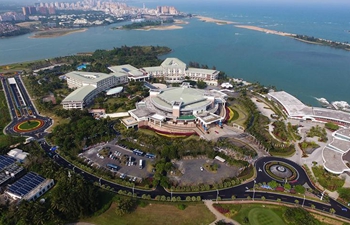
Dutch Minister of Foreign Affairs Stef Blok holds up a photo of a Syrian girl as he addresses a United Nations Security Council meeting on the humanitarian situation in Syria, at the UN headquarters in New York, March 27, 2018. UN Undersecretary-General for Humanitarian Affairs and Emergency Relief Coordinator Mark Lowcock said Tuesday that the last few months have been some of the worst for Syrian civilians as a result of ongoing violence. (Xinhua/Li Muzi)
UNITED NATIONS, March 27 (Xinhua) -- UN Undersecretary-General for Humanitarian Affairs and Emergency Relief Coordinator Mark Lowcock said Tuesday that the last few months have been some of the worst for Syrian civilians as a result of ongoing violence.
In the besieged rebel stronghold of Eastern Ghouta in the outskirts of Damascus, more than 1,700 people have been reportedly killed since Feb. 24, the day of adoption of Security Council Resolution 2401, which demands an immediate cease-fire across Syria, Lowcock told the Security Council in a briefing.
Attacks on critical civilian infrastructure like medical facilities continue to be reported. There have been at least 28 reported attacks on health facilities since mid-February and more than 70 verified incidents since the beginning of this year, said Lowcock via video teleconference in Geneva.
In Damascus city, at least 78 people were reportedly killed and 230 others injured by shells fired from Eastern Ghouta in recent weeks. They include reports of at least 35 people killed and scores wounded on March 20 when a market in Jaramana, a southeastern suburb of the city, was struck by a rocket, said Lowcock.
Tens of thousands of civilians have been displaced across the country in recent weeks, he said.
Nearly 52,000 civilians from Eastern Ghouta are currently being hosted in eight collective shelters in rural Damascus. Most of the collective shelters do not have the capacity or infrastructure to accommodate such large numbers of people, he said.
In northwest Syria, an estimated 183,500 people have been displaced by hostilities in Afrin district in Aleppo governorate in recent weeks. The majority, some 140,000 people, have fled to Tal Refaat. This massive influx of internally displaced persons is putting a strain on host communities, which are already overwhelmed.
In Idlib governorate, the situation remains catastrophic, with almost 400,000 people displaced since mid-December. Local capacity to assist is overstretched. Thousands of additional people are now coming there from Eastern Ghouta, with no sites or shelters available for the vast majority of them, said Lowcock.
There are reports of an increase in violence in Idlib in recent days, he said. On March 20, airstrikes hit a shelter for internally displaced persons in the outskirts of Haas village in southern rural Idlib governorate, killing at least 10 people and injuring 15 others, he quoted local sources as saying. On the following day, airstrikes on Kafr Battikh village in the same area reportedly killed scores more. The next day, the central market in Harim town was hit by an airstrike, reportedly killing 35 people, including many women and children.
Airstrikes also resumed in southern Syria on March 12, with attacks being reported in and around Daraa City on the border with Jordan. There have not been airstrikes in these areas since an agreement was reached last year on the creation of a de-escalation zone for parts of the south of the country. This therefore appears to be a major unwelcomed development, said Lowcock.
The Syrian civil war has entered its eighth year.















